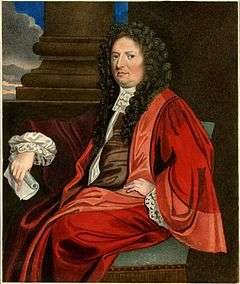Robert Plot

Robert Plot (13 December 1640 – 30 April 1696) was an English naturalist, first Professor of Chemistry at the University of Oxford, and the first keeper of the Ashmolean Museum.
Early Life and education
Born in Borden, Kent to parents Robert Plot and Elisabeth Patenden, and baptised on 13 December 1640, Plot was educated at the Wye Free School in Kent. He entered Magdalen Hall, Oxford in 1658 where he graduated with a BA in 1661 and a MA in 1664. Plot subsequently taught and served as dean and vice principal at Magdalen Hall while preparing for his BCL and DCL, which he received in 1671 before moving to University College in 1676.[1][2]
Natural history and chemistry
By this time, Plot had already developed an interest in the systematic study of natural history and antiquities.[3] In June 1674, with patronage from John Fell, the bishop of Oxford, and Ralph Bathhurst, vice-chancellor of the university, Plot began studying and collecting artefacts throughout the nearby countryside, publishing his findings three years later in The Natural History of Oxford-shire.[1] In this work, he described and illustrated various rocks, minerals and fossils, including the first known illustration of a dinosaur bone which he attributed to a giant (later recognised as the femur of a Megalosaurus), but believed that most fossils were not remains of living organisms but rather crystallisations of mineral salts with a coincidental zoological form.[3]
The favourable reception of his findings not only earned him the nickname of the "learned Dr. Plot," but also led to his election into the Royal Society of London on 6 December 1677, where he served as the society's secretary and joint editor of the Philosophical Transactions (144–178) from 1682 through 1684.[1] Another implication of his success was his appointment as the first keeper of the newly established Ashmolean Museum in 1683, as well as his simultaneous appointment as the first professor of chemistry in the new well-equipped laboratory housed within the museum.[2]
In the field of chemistry he searched for a universal solvent that could be obtained from wine spirits, and believed that alchemy was necessary for medicine. In 1684, Plot published De origine fontium, a treatise on the source of springs, which he attributed to underground channels originating from the sea. Plot shifted his focus towards archaeology in the 1686 publication of his second book, The Natural History of Staffordshire, but misinterpreted Roman remains as Saxon.[2] He also describes a double sunset viewable from Leek and the Abbots Bromley Horn Dance.[4][5]
Later life and death
In 1687, Plot was made a notary public by the Archbishop of Canterbury as well as appointed the registrar to the Norfolk Court of Chivalry.[1] Plot resigned from his posts at Oxford in 1690, thereafter marrying Rebecca Burman of London and retiring to his property of Sutton Barne in his hometown of Borden, where he worked on The Natural History of Middlesex and Kent but never completed.[2] The office of Mowbray Herald Extraordinary was created in January 1695 for Plot, who was made registrar of the College of Heralds just two days later.[1] Although able to go on an archaeological tour of Anglia in September 1695, Plot was greatly suffering from urinary calculi, and succumbed to his illness on 30 April 1696. He was buried at Borden Church, where a plaque memorialises him.[3]
References
| Wikimedia Commons has media related to Robert Plot. |
- 1 2 3 4 5 A. J. Turner, 'Plot, Robert (bap. 1640, d. 1696)', Oxford Dictionary of National Biography, Oxford University Press, 2004 accessed 4 June 2013
- 1 2 3 4 Plot, Robert." Complete Dictionary of Scientific Biography. Vol. 11. Detroit: Charles Scribner's Sons, 2008. 40–41. Gale Virtual Reference Library. Web. 4 June 2013.
- 1 2 3 "Robert Plot: A brief biography of this important geologist's life and work." (PDF). Oxford University Museum of Natural History. Retrieved 4 June 2013.
- ↑ "Dr. Plot and the Amazing Double Sunset". leekonline.co.uk. Retrieved 27 March 2005.
- ↑ Kent, Jeff (2001). The Mysterious Double Sunset. Witan Books. pp. 34–35 and 38–42. ISBN 0-9529152-5-1.
Additional Resources
- Plot, Robert (1705). The Natural History of Oxford-shire: Being an Essay Towards the Natural History of England (2nd ed.). Oxford: Printed by Leon. Lichfield.
- The Correspondence of Robert Plot in EMLO
-
 "Plot, Robert". Dictionary of National Biography. London: Smith, Elder & Co. 1885–1900.
"Plot, Robert". Dictionary of National Biography. London: Smith, Elder & Co. 1885–1900. -
 Chisholm, Hugh, ed. (1911). "Plot, Robert". Encyclopædia Britannica (11th ed.). Cambridge University Press.
Chisholm, Hugh, ed. (1911). "Plot, Robert". Encyclopædia Britannica (11th ed.). Cambridge University Press. - Robert Plot from the Ashmolean Museum, Oxford
External links
Plot, Robert (1676) The natural history of Oxford-shire - digital facsimile from the Linda Hall Library